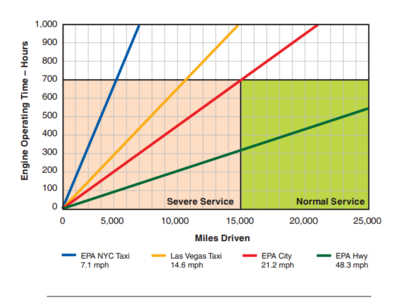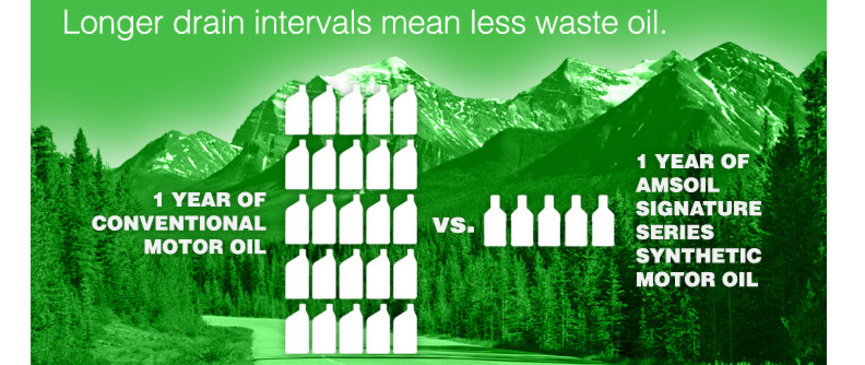INDEPENDENT DEALER
Wolcott, CT | (203) 592-7113

Determining an Engine Oil Drain Interval
What does Seven Hundred Hours, One Year and 25,000 Miles have in common? These three measurements work in conjunction to maximize the protection that AMSOIL’s Signature Series Synthetic lubricants can provide your naturally aspirated, gasoline fueled passenger vehicle’s engine in normal service.
Let’s take a further look. When you lubricate your vehicles engine with the appropriate viscosity grade of AMSOIL’s Signature Series Synthetic lubricant, the oil change interval will be the first occurrence of seven hundred hours, one year or 25,000 miles. If seven hundred hours occurs first, your vehicle likely has experienced a significant amount of low speed stop and go driving and a higher amount of idle time. When a year passes first, your vehicle has likely experienced very low usage and or a mix of city and highway driving with short trips. Now if 25,000 miles of driving occurs first, chances are your vehicle was driven daily at highway speeds for an hour or more at a time. These are general scenarios, but I think you get the idea. The first occurrence of one of these three values will trigger an oil change.Turbo charged, super charged, direct injection and commercial use gasoline fueled engines follow a severe service usage and shorten the mileage interval to 15,000 miles but the seven hundred hour and the one year interval remain the same.
From AMSOIL's January 2017 Dealer Magazine:
EFFECTS OF EXCESSIVE ENGINE IDLING
Excessive idling leads to more than just poor fuel economy.
Engine idling is often unavoidable during day-to-day vehicle operation. Whether it’s sitting in traffic or waiting in the school parking lot, excessive idling creates engine wear without advancing the odometer.
The detrimental effects of high idle times are numerous:
• Decreased fuel economy
• Incomplete fuel combustion, leading to fuel dilution and lowered oil viscosity, additive concentration and oil pressure – all of which increase the risk of wear
• Increased oil consumption
• Compromised injector tips, turbochargers and valve seats (diesel engines)
• Incomplete fuel combustion, leading to fuel dilution and lowered oil viscosity, additive concentration and oil pressure – all of which increase the risk of wear
• Increased oil consumption
• Compromised injector tips, turbochargers and valve seats (diesel engines)
The service life of a motor oil is described in miles; however, it is greatly affected by a vehicle’s operating conditions. This is why AMSOIL provides definitions for normal and severe service. Commercial and fleet vehicles are automatically included in the severe service category due to the nature of their operating conditions. Vehicles that frequently tow, haul and plow are obvious candidates for the category, but excessive idling is often overlooked.
AMSOIL Signature Series Synthetic Motor Oil represents the pinnacle of oil formulation, but all oils eventually lose their ability to provide proper lubrication and component protection. We recommend changing Signature Series Synthetic Motor Oil after 700 hours of operation, in addition to the other established guidelines.
 The graph to the right illustrates the importance of tracking both mileage and idle time. It shows the hours of engine operation, or idle time, versus the miles driven during a drain interval. The colored lines represent average speeds of a vehicle in four different scenarios.
The graph to the right illustrates the importance of tracking both mileage and idle time. It shows the hours of engine operation, or idle time, versus the miles driven during a drain interval. The colored lines represent average speeds of a vehicle in four different scenarios. Following the orange line in the graph shows that the Las Vegas taxi accumulated approximately 10,000 miles before reaching the 700-hour mark. It operated for the same amount of time as the New York City taxi, but traveled twice the miles. This is a clear example of how the hour limitation can significantly impact the number of miles accumulated during a drain interval.
Signature Series Motor Oil counteracts some of the effects of prolonged idling by helping prevent deposits and resisting oil volatility (burn-off). Its unique synthetic formulation maximizes energy efficiency for optimum fuel economy.
If you do a lot of idling, is vital to install a quality motor oil in your vehicle and maintain an accurate log of both mileage and hours of engine operation. Combining Signature Series Motor Oil with the appropriate drain interval will help prevent engine wear and costly repairs.
Read here the full Las Vegas Taxi Cab Study.

AMSOIL Signature Series Synthetic Motor Oil







